 |
|
 |
|
Wine World
by Colin Kaye |
|
|
|
Persistent Myth
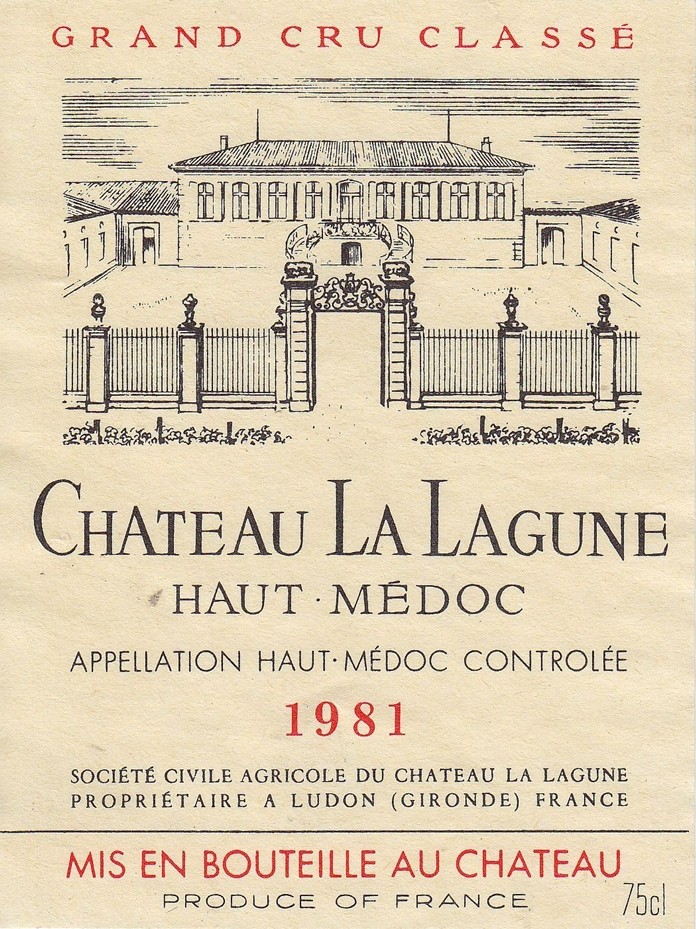
Few wines are made for ageing.
Some time ago, I was having dinner
at one of my favourite restaurants (now sadly gone) and I noticed someone at
a nearby table ordering a bottle of wine. My ears instinctively switched
into bionic mode and I realized that he was ordering a fairly ordinary but
reliable French wine, often seen in these parts. A few minutes later, the
waitress appeared, opened the bottle and poured a sample. This was airily
dismissed with something like, “Oh, I know this wine; I don’t need to taste
it.” Of course, the man had missed the point entirely. He wasn’t being given
a sample to see if he liked it because by ordering the wine, he had already
bought it. The sample is to check that the wine has not been damaged or
“gone off” in some way. It’s merely a quality check. In any case, tasting is
not strictly necessary. With experience, a few quick sniffs reveal whether
the wine is acceptable.
There’s a raft-load of other
misconceptions and wine myths that have been around far too long. Here are
six of them in no particular order.
Myth No 1: Leave the opened bottle of wine
to stand before serving.
This is a common belief held by
waiters who have presumably been instructed by the management to let the
bottle stand for a few minutes on the table “to let the air in”. This is
nonsense, because the air can reach only a tiny surface area of the wine in
the narrow neck of the bottle. If the wine needs aerating (and some don’t),
it’s better to pour it and then let it rest in the glass for a few minutes.
Myth No 2: Screw top closures signify cheap
wine.
At one time, almost all wine bottles
were sealed with cork but today screw caps have become so reliable that most
everyday wines use them. The majority of Australian and New Zealand wines
use them regardless of quality. Screw caps are preferred by many European
wine producers too. It is only a comparatively tiny percentage of wine
intended for long-term ageing that are thought to benefit from a cork
closure.
Myth No 3:
“Legs” in the glass indicate high quality wine.
You’ve probably seen those rivulets
of liquid that adhere to the inside of the glass. They’re caused by a rather
complex physical phenomenon involving surface tension and alcohol
evaporation and often found in wine with either high alcohol or sugar
content. It’s known as the Marangoni Effect has nothing to do with
quality. A thesis on the subject brought the eponymous Carlo Marangoni his
doctorate degree in 1865.
Myth No 4:
Wine always improves with age.
Most of the wine in the world is
made for consumption within a couple of years. After that it’ll lose much of
its freshness; the taste will start to fade and the wine will sadly become a
shadow of its former self. The majority of wines deteriorate with age. The
exceptions are the small percentage of wines made for ageing, such as top
quality wines from Bordeaux and Burgundy.
Myth No 4: Blended wines are inferior.
Almost every wine is blended. Classic Bordeaux
for example, is usually a blend of at least three grapes. Wine made from a
single grape variety is called a varietal and usually (but not
always) has the name of the grape on the label. However, regulations
allow a proportion of other grapes to be used. In Europe a varietal must
contain 85 percent of the grape shown on the label but in America it’s only
75 percent. Relatively few wines are made entirely from a single grape
variety.
Myth No 5: Red wine should always be served
at room temperature.
This myth implies that all red wines
should be served at the same temperature, which is simply untrue. Both
humidity and temperature have a significant impact on how a wine smells and
tastes. And in any case, what is the temperature of a room? Most red wines
are at their best when the temperature is below 70°F (or 21°C) which is
lower than most domestic temperatures, especially in this part of the world.
Here, red wine should feel slightly cool, but not cold. Full-bodied reds
such as Cabernet Sauvignon or Merlot should be about 64°F. Light, fruity
Beaujolais is always served distinctly cool in its home country at about
53°F. For the best advice, look at the back label on the bottle. If in
doubt, cooler is better for the wine will soon heat up in the glass.
Myth No 6: Always drink red wine with
cheese.
Yes, Pinot Noir works well with
Emmenthal or Gruyère, while Edam (AY-dum) and Gouda (HOW-dah) can go well
with Cabernet Sauvignon. But these two Dutch favourites also work superbly
with dry Riesling. Many cheeses taste better with white wine rather than
red. Brie and Camembert work perfectly with Chardonnay, Chenin Blanc or even
Sauvignon Blanc. Blue cheese often calls for sweet white wine and
amontillado sherry will probably go with many varieties of cheese. The best
means of discovery is to have a cheese and wine pairing experiment yourself
and find out what combinations work. Assuming of course, that you have the
time, the inclination and the money.
|

|
Sweet Talk
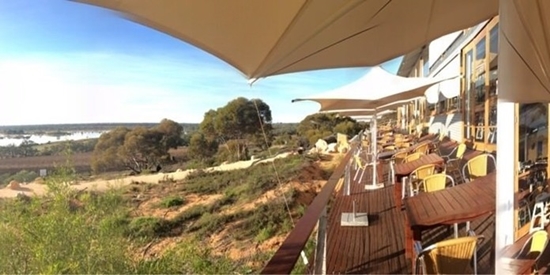
Banrock
Station Wine and Wetland Centre.
I was in Hungary at the time - Budapest
to be exact - staying at a cheap lodging in a rather run-down part of town.
It was here, one evening that I had my first taste of classic sweet wine. It
was Hungarian Tokay Aszú, the world-famous and somewhat mystical
golden wine known throughout the English-speaking world as Tokay (tock-eye).
It was ravishingly sweet. For hundreds of years it was
the favourite wine of the wealthy aristocracy of Europe, Russia and Poland.
Earlier in the day, I had chanced upon a small wine shop where the
enthusiastic owner persuaded me to buy a bottle. In those days I was not
used to drinking wine regularly and this unfamiliar yet sumptuous wine
turned out to be higher in alcohol than I had expected. Later that night, I
found myself effortlessly levitating inside the vast spaciousness of St
Stephen’s Basilica in Budapest.
To wine enthusiasts, the mention of sweet wine brings
memories of German Eiswein or those two splendid French dessert
wines, Sauternes and the rather lesser-known Barsac, both of which come from
the Bordeaux region. Because of the high sugar content they age well and
have a lovely soft, slightly syrupy texture though they are rarely cloying.
The most famous is
Château d'Yquem
which is regarded with reverence among wine connoisseurs. Vines have been
planted at the château since 1711 and the legendary sweet wines are noted
for their concentration and complexity of taste. They are long-lasting wines
which can develop in the bottle for over a hundred years and some remarkably
old vintages are still available – if you can afford them. You can buy
Château d'Yquem
in Thailand although a single bottle of the relatively recent 2007 vintage
will set you back Bt 55,000. I tend not to drink it very often.
Although sweet wines are usually served only at the end
of formal dinners, they can bring an extra dimension to your desserts at
home. You’ll probably be pleased to know there are cheaper alternatives to
Château d'Yquem.
You can buy a decent bottle of Sauternes at more earthly prices and the
sumptuous, fruity and honeyed Barton & Guestier Passeport Sauternes
is about Bt 1,500 from Wine Now Asia. I’ve also seen the excellent Louis
Eschenauer Sauternes in Villa for about Bt 900.
If you’re looking for something even cheaper to liven
up your dessert, the Muscat grape can come to your rescue. Surprisingly
there are over two hundred different varieties of Muscat (or Moscato) and
they have been around for centuries. In more recent years the grape has been
grown successfully in Australia.
Banrock Station Moscato 2019 (white), Australia. Bt
550 @ various outlets
The curiously named Banrock Station has acquired
something of a reputation for popular fruit-forward wines which are easy on
the palate. This one is a straw colour with attractive hints of green. It
looks inviting and although the first sniff might possibly remind you of
Sprite, more subtle aromas of pomelo and melon soon come through. You’ll
probably pick up the distinctive Muscat aroma too.
This is a lively easy-drinker which tickles the tongue
with its delicate sprizty quality. There’s a surprisingly long and
satisfying finish too; unusual for a wine at this price tag. The wine is
only 5.5% ABV which is about the same as our local beer. You can serve
dessert wines as cold as you dare. I’d prefer this straight out of the
fridge and even then I might give it another twenty minutes in the freezer.
In our sultry climate it’ll soon warm up and allow the aromas to emerge. Not
only will this work well as a dessert wine, you could also try this light
and easy wine as an apéritif.
Deakin Estate Moscato 2014 (white), Australia. Bt
550 @ Wine Connection
This is a really easy drinker and although it comes in
the “sweet” class it would be more accurately described as “semi-sweet”.
Deakin Estate is a relative newcomer to the Australian wine scene. Although
the land was bought in 1967, the company didn’t start producing wine until
the 1990s by which time some of the vines had achieved a venerable age. This
particular wine has won several prestigious awards including a bronze medal
at the UK’s International Wine Challenge.
To my mind, this is a splendid dessert wine if you want
to keep the price as low as possible. It’s a pale yellow wine with faint
hint of lime on the aroma and the distinctive smell of sweet raisins. And
this incidentally is one of the hallmarks of Moscato because as far as I
know, it’s the only wine that actually smells of grapes. The taste has a
delicate acidity and a slightly spritzy quality which makes it delightful
refreshing. At only 6% ABV this wine is remarkably low in alcohol and
there’s an attractively long finish too. There are hints of green apples on
the palate and this proved a perfect match for my home-made apple pie. I use
a recipe from my Scottish grandmother, who in all probability received the
recipe from her Scottish grandmother. The apple pie could have even
been a favourite of Robert Burns. It would be pleasing to imagine that old
Rabbie washed it down with a few glasses of sweet Hungarian Tokay.
|

|
Wine from a long, thin country
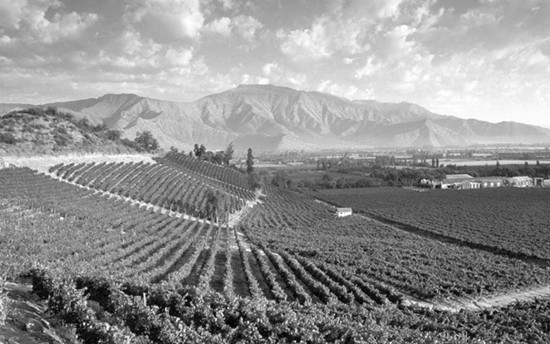
The Andes
dominate Chilean vineyards.
In recent months, several bargain-basement Chilean
wines have started to appear, giving locally-produced fruit wines a run for
their money. There’s a good selection at Big C in South Pattaya where they
offer several wines well under Bt 400, most of which were produced and
bottled by the same Chilean company. They can often be recognized by their
outlandish names.
The long, thin country of Chile is confined between the
Andes Mountains to the east and the Pacific Ocean to the west. Its vineyards
lie along an 800-mile stretch of land that has a temperate climate similar
to that of California. You might be surprised to know that they’ve been
growing vines in Chile since the sixteenth century, after the country was
colonized (or invaded, if you prefer) by the Spanish around 1554. You’d
have thought that the Spanish would have encouraged the locals to develop
their own wine industry. But no such luck. During Spanish rule, Chilean
vineyards were restricted in production and the Chileans were instructed to
buy all their wine from Spain. To their credit, most of them didn’t because
they preferred their own wine. In any case, after a rough voyage across the
Atlantic, much of the Spanish wine would probably be oxidized and barely
drinkable. In 1641, in the true spirit of imperial colonialism, the
mean-minded Spanish banned Chile from exporting its wine, but this unfair
ruling was also largely ignored.
The disastrous appearance of the phylloxera epidemic in
mid-19th century Europe brought an unexpected bonus to the
Chilean wine industry. With countless French vineyards in ruin, many wine
makers moved to South America bringing their experience and techniques with
them. As a result, the history of wine making in Chile was largely
influenced by the French, especially the wine-making traditions of Bordeaux.
Even so, during the first half of the 20th century, Chilean wine
was considered rather low quality but substantial foreign investment and
technical advances had an enormous impact with the result that by the end of
the 20th century, Chile was producing some world-class wines.
Quincho Dry White (Chile) Bt 345 @ Big C
They don’t come much cheaper than this, an entry-level
wine produced and bottled in Chile. In case you’re wondering, quincho
(KEEN-cho) is the Spanish word for barbecue. There’s a picture of one
on the back label, which also contains the mystifying expression “Secret Dry
White” though what the secret is I have yet to discover.
The wine is a pale straw colour with an attractive
fruity aroma of honey, pomelo and dusty pineapple, if you can imagine dusty
pineapple. The wine smells more expensive than it actually is and if someone
gave me a glass of this to taste, on the aroma alone I’d estimate the price
to be around Bt 700. And yet, I often see people trying a wine for the first
time and not bothering to sniff it first. It seems such a dreadful omission.
There’s much more fruit on the palate than I expected,
dominated by honey and pineapple. The taste blooms in the mouth too,
something you wouldn’t normally expect with a wine at this price. It’s quite
a dry wine, though the dryness is offset by generous fruit. The acidity is
quite low too and at just 11.5% ABV this wine could be enjoyed on its own.
Quincho Dry Red (Chile) Bt 345 @ Big C
To my surprise, this bottle was closed with a cork,
albeit a synthetic one. Nearly all wine bottles these days are sealed with
the so-called Stelvin closure which is the fancy name for the familiar
screw-cap. The cork was rather reticent too, and I had to ferret out my
strong twin-lever bottle opener which can deal with the most stubborn corks.
I doubt whether a simple cork screw would stand much of a chance.
This entry-level wine is a rich dark red with a
distinctive purple hue. It has an aroma of plums and jammy fruit yet the
body is quite light with plenty of tannin. I know that many people prefer
loads of fruit on the palate but sometimes less is more, especially if you
plan to drink this wine with food. And I hope you do, because to my mind
this is a “food wine”, even if the food happens to be bread and cheese or a
humble beef burger. It’s distinctively dry and the style slightly reminds me
of simple Bordeaux, the sort that the French buy every day in large plastic
bottles.
This wine is significantly cheaper than Mont Clair,
the work-horse wine of almost every bar in town and I thought it might be
interesting to compare them. The wines I mean, not the bars. The Quincho
smells vaguely French whereas the Mont Clair smells like, well,
Mont Clair. The Quincho feels firm, dry and slightly austere
whereas the Mont Clair is slightly fuller, a little less dry and
blended for smoothness. Other than that, there’s not a great deal of
difference between them except fifty baht. And fifty baht is fifty baht.
|

|
Cheap Fizz
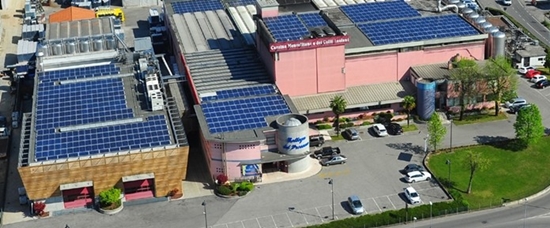
Cantina
Montelliana, Treviso.
One of the enduring puzzles about Italian wine is that
the name shown on the label can be one of four different things. It could be
the name of the grape (e.g. Moscato), the name of the wine region (e.g.
Chianti), the name of the town from which the wine comes (e.g. Bardolino) or
in many cases, the name of the wine producer (e.g. Frescobaldi). But one
wine springs to mind that is especially confusing in the nomenclature
department. It’s Prosecco.
In the first place, Prosecco is the name of a style of
wine. It’s often considered a cheap version of Champagne and indeed the
taste profile shows a few broad similarities. But Prosecco is also a place.
Many years ago it used to be a small village but has now been absorbed into
the sprawling suburbs of Trieste and lies about 800 feet above the
Mediterranean up in the extreme north east of Italy. Naturally, they make
Prosecco wine there and have done so since the 16th century, but
in more recent years the main production area for Prosecco has moved to a
region about twenty miles north of Venice. The main town is Treviso.
Prosecco is also the name of the thin-skinned green
grape that makes the wine. Or at least, it used to be until 2009 when the
regional wine authority decided that the official name of the grape should
be Glera, a name by which it had been known locally for generations.
Today the wine is made in nine provinces in the Conegliano-Valdobbiandene
region, a lush, green and hilly area where the best vineyards lie on the
south-facing slopes. Although a small quantity of still wine is produced,
Prosecco is nearly always sparkling or semi-sparkling.
You might wonder why Prosecco is invariably cheaper
than Champagne, especially when they sometimes taste slightly similar. The
reason lies in the bubbles - or rather how they’re made. Prosecco is made
using the so-called Charmat Method which although invented by an
Italian at the end of the 19th century, was further developed by
the French inventor Eugène Charmat in 1907. This method is used all over the
world to produce cheap brands of sparkling wine. In Treviso, it’s often
known as the Metodo Italiano an expression that hardly needs
translation.
The wine is blended and initially fermented using
stainless steel pressure tanks in which the bubbles form during the second
fermentation. This is less time-consuming (and therefore cheaper) than the
more complicated and labour-intensive Champagne Method. Prosecco is often
used as an apéritif but it’s surprisingly versatile and pairs successfully
with a wide range of food. It works well with medium-intensity foods but can
also matches the spicy curries and many other dishes of Southeast Asia.
Cornaro Prosecco Extra Dry DOC,
Treviso, Italy (white) 644 THB @ Villa
This wine comes from the dauntingly named Cantina
Montelliana e dei Colli Asolani, a cooperative of associated
vine-growers founded in 1957. Its vineyards are located on the
southern-facing hills around Montello and Colli Asolani several hundred feet
above sea level. This example comes from the lower end of the price range
though don’t let that put you off. Although it is one of the cheapest
sparklers around, to my mind it’s jolly good value. The wine is a pale straw
colour and has an attractive aroma of apple and peach. At just 11% ABV, it’s
supple and light in body but quite an undemanding wine and not the kind of
thing that requires elaborate descriptions. I’d describe it as a simple
swigger and none the worse for that, because it would be ideal for social
occasions or parties, if we are ever allowed to have them again.
Maschio Prosecco Extra Dry DOC,
Treviso, Italy (white) 644 THB @ Villa
No, it’s not a typing error. The price of these two
sparklers wines is exactly the same, though in England they cost about ten
quid a bottle. Cantine Maschio is one of Italy’s top producers of
quality Prosecco and makes some of the best-selling wines in Italy. This
entry-level wine is almost colourless with subtle hints of green. There’s an
interesting dusty floral aroma with the distinct smell of herbs and a hint
of peaches. The wine is exceptionally light, dryish and refreshing with
plenty of fruit of the palate and a pleasingly rounded taste with delicate
acidity and lively bubbles. There’s also a surprisingly long finish and this
charming little sparkler has a real touch of class. At just 11% ABV it would
make a splendid aperitif, light and easy with not too much acidity.
Incidentally, if the label describes a sparkling wine
as “extra dry” (which both these do) it’s not very dry at all. If you want a
really dry sparkler, look for the word “Brut” on the label. Either
way, Prosecco should always be served cold at around 3-6 °C which is pretty
well out-of-the-fridge temperature. Most wine enthusiasts agree that
sparkling wines should always be served in one of those tall, elongated
tulip glasses, known technically as Champagne flutes. The shape helps
preserve the bubbles for longer and it concentrates the wine’s fruity aromas
at the top of the glass where your nose should be. Unless of course, you are
some kind of alien being, with your nose in an unusual place.
|

|
A Sense of Place
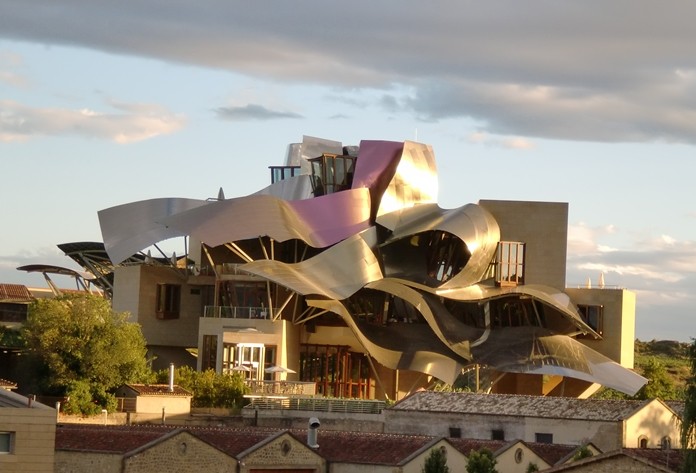
The novel design of the Marqués de Riscal hotel.
Yesterday afternoon I was looking through a newsletter
from a wine company in Bangkok and I was mildly surprised to see some Rioja
among their offerings. You might not be familiar with the name and I have to
admit you don’t see them around here very often. For many people, the name
itself is a bit of a challenge. Being Spanish, the “j” is pronounced like
the “ch” in the Scottish word “loch” or a bit like the “ch” that occurs in
many German words. The entire word should come out something like
ree-OCH-ah but I don’t suppose it matters very much how you say it
around here.
You could be forgiven for assuming that Rioja is the
name of a grape, but it’s a place, or more accurately, a wine region. The
name comes from the river that flows through the region, the Rio Oja. Here
they produce some of the best wines in Spain. Rioja lies in the far north of
the country, not far from the border with France and about 120 miles south
of Bilbao. Wine making in this region has a long history, so long in fact
that no one is really sure exactly when it began. The origins of Rioja go
back to the Phoenicians and there is certain evidence that grapes were grown
in La Rioja during the ninth century. In medieval times, La Rioja had many
vineyards which were tended by monks, a common practice at the time. Today
the vineyards cover about 160,000 acres. Most of the region produces red
wine but the whites are also interesting.
I first discovered Rioja about forty years ago and
intrigued by the elegant Bordeaux-shaped bottle surrounded by its
traditional golden wire mesh. I took the bottle home and thus began a long
love affair with this splendid wine which, along with Sherry, seems to me
the epitome of Spain. The Bordeaux-shaped bottle is perhaps not a
coincidence because at first the wine reminded me of Cabernet Sauvignon. But
there was something else. It reminded me of Spain, the gloomy interiors of
the country houses, the dark and heavy furniture and the rich textures of
traditional Iberian fabrics. The wine had a “sense of place” which I found
captivating. Perhaps it’s something to do with the grape variety. You see,
Rioja’s dominant grape is the Tempranillo, the great red grape of Spain.
It’s been grown there for over two thousand years and shows up all over the
country with the result that it has several local names including Abundante,
Tinto Fino and Tinta de Toro. Sometimes another grape, the garnacha (known
in France as the Grenache) as added to Rioja to create a richer fruitier
taste. In 2007, the wine regulating body for the Rioja region decided to
allow several more local grapes to be used in the making of Rioja.
Young, red Rioja is a dark wine with medium acidity,
substantial tannins and sometimes hints of jam and red fruit. Older wines
have a complex aroma with hints of vanilla and coconut which comes from
ageing in American oak. Some of the finest Riojas are, to my mind, almost on
a par with good Bordeaux and certainly share some of the taste qualities.
These older wines often have a silky, smooth texture brought about by
several years maturing in oak barrels.
Although Rioja is produced in different parts of the
region, that doesn’t really concern us here. It’s more important for the
buyer to know the four quality levels of Rioja. The entry level is simply
labeled “Rioja”. This has minimal ageing but is low in tannin and high in
fruit. If you enjoy light fruity wines, you’ll probably enjoy it. The next
level up uses the word “crianza” on the label and it spends a year in oak
and a few months in the bottle before it can be sold. This wine has more
body and often hints of oak. The next rung of the ladder uses the word
“reserva” and these are wines are of noticeably higher quality, having had
three years in the barrel. Wines at the top of the tree are allowed to use
the words “gran reserva” on the label. These are among the best Riojas that
you can get and are required to have at least two years in oak barrels and
three years in the bottle. If you are into beef steaks, this is a wine to
try with them.
Several excellent
brands of Rioja are available in Thailand and the widest choice comes
through online sources. Marqués de Riscal have been producing
top-class Rioja since 1858 and the winery also has a
luxury
hotel on site, designed by Frank Gehry using methods he previously employed
in the Guggenheim Museum Bilbao.
Marqués de Cáceras is also an old-established
company and you can obtain their
Rionja Crianza for under 900 baht. Wine Connection has the Federico
Paternina Banda Azul Crianza for under 600 baht, which is an excellent
bargain. Wine Garage sells the CVNE Rioja Crianza for Bt 900 and the
excellent Contino Rioja Reserva for Bt 1,900. Wine Garage also has an
unusual white Rioja, the CVNE Monopole at Bt 975. I first tasted the
1968 vintage of this wine sometime in the late 1970s and it had turned into
a beautifully balanced, dry and elegant wine. I have not tasted recent
vintages, but it is sure to make an interesting change from Chardonnay.
Rioja wine has so much to offer and so easily available here that it would a
shame not to try some of them.
|

|
Avoiding Expensive Mistakes
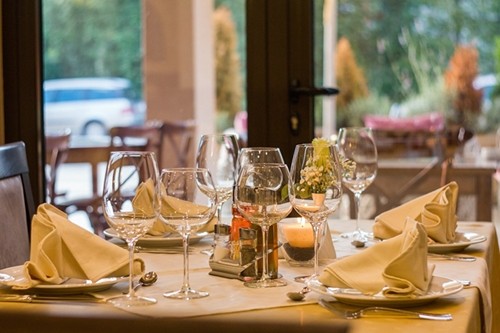
(Photo by Nenad Maric.)
by Colin Kirkpatrick
A few months ago, before the Days of the Great
Pandemic, I was having an evening meal with some friends at an Italian place
in Bangkok. There were several wines on the table including a bottle of
Cabernet Sauvignon. Towards the end of the meal, someone ordered a desert, a
kind of Italian apple and lemon pie with lashings of cream. To my
astonishment he reached for the Cabernet Sauvignon, poured himself a glass
and then happily swigged it with the desert. I assumed that a fuse must have
blown in his gustatory system for the disastrous combination of dry, tannic
wine, sweet apples, lemon and cream would have tasted revolting. The
flavours must have been fighting each other to the death.
You probably know of several food and drink
combinations that just seem that they don’t work. Could you for
example, imagine eating a fried egg with a glass of rich, fruity Merlot? The
thought makes me cringe. There might be a remote possibility that fried egg
and Merlot is a taste made in heaven just waiting to be discovered but I
somehow doubt it. Some wine enthusiasts claim that you can drink champagne
with fried eggs because the acidity in the wine cuts the palate-coating
taste of yolk. But it would just feel wrong. To my mind, the only
successful partner to a fried egg is a cup of tea.
Food and wine have been close companions for centuries,
because generally they go together so well. But there are a number of
combinations that simply don’t work largely on account of the chemistry.
Wine is expensive enough, without wasting a good bottle on the wrong food.
It could ruin the evening. The whole business of food and wine pairing might
seem like a minefield, but it boils down to a simple fact: you need the wine
and the food to complement each other so that they both improve in each
other’s company.
In a restaurant, choose a wine that fits your budget.
And play it safe rather than risk a dodgy experiment with the unknown,
especially if the unknown costs Bt 3,000 a bottle. I usually prefer to keep
things simple with three rules of thumb: (1) match the weight and texture,
(2) match the intensity, and (3) either contrast the flavours or let them
complement each other.
If you were to drink a young white with a rich and
fully flavoured beefy dish, the wine would probably taste thin and watery.
Delicate flavours of fish dishes need a light, delicate wine. A hefty
full-bodied red would overpower the food completely and render it pretty
well tasteless. Even so, there’s no point in drinking dry-as-a-bone
Sauvignon Blanc with lightly cooked shellfish – a classic combination by the
way - if you loathe and detest Sauvignon Blanc.
And talking of fish, you may recall that much-quoted
saying, “white wine with fish; red wine with meat.” It’s an
over-simplification of course. Some light reds work well with rich,
assertive fish dishes and many whites work well with veal or chicken. While
some reds take on an unpleasant metallic quality when paired with fish,
grilled salmon works really well with Pinot Noir. Some of the classic food
pairings, tried and tested over generations are worth bearing in mind:
Chablis or Muscadet with oysters; red Burgundy with coq au vin;
Cabernet Sauvignon with steak; Sauternes with foie gras and
Chardonnay with lobster. If you can afford caviar, bring out the Champagne.
For many of us, food choices are rather more mundane.
What about fish and chips for example? You might be surprised to know that
Champagne goes well with this British favourite, or Prosecco if you’re on a
budget. My own choice would be Sauvignon Blanc or Pinot Grigio though I’ve
heard that Chenin Blanc goes a treat with mushy peas.
For beef burgers, chose Pinot Noir or a fruity Merlot.
Hot dogs go well with a cold fresh dry rosé or even a spritzy white. Veggie
omelets complement light dry whites like Chablis or Soave but more robust
omelet fillings need a simple country red. Indian food generally calls for
low alcohol wines and Riesling, Sauvignon Blanc or Gewürztraminer are
appropriate choices.
Thai food generally works well with light dry whites
such as Pinot Grigio, Soave, Chenin Blanc or dry rosé. Leave the reds on the
shelf. The choice of wine with chicken depends on how the meat cooked, but
generally rich dry whites or light reds work well. Pinot Noir is the classic
wine choice for duck.
Wine and cheese have long been traditional partners but
there’s a persistent myth that cheese will go with almost any red wine. I
disagree. Full-bodied reds and soft cheese (such as Brie or Camembert) don’t
work because the tannins make the cheese taste chalky. Dry, crisp whites are
far more suitable. Save the red for richer items. Riesling and Chardonnay
usually go well with Swiss cheese. Riesling also works well with two popular
Dutch cheeses, Gouda and Edam. British mature Cheddar can be a problem, and
I’ve read all sorts of suggestions that range from Californian Zinfandel to
late-bottled Port. My own preference, especially for a summer lunch, would
be a cold beer.
|

|
Over the Hill
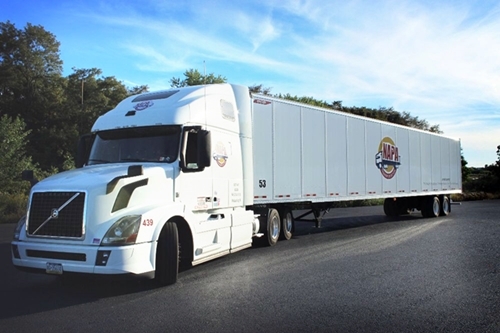
Bulk wine on the move.
The other week, someone asked me why there’s never a “best
before” date on bottles of wine. It’s a good question. After all, they
appear on almost all other consumables, even cans of dog food. So why not
wine? Some boxed wines have the packing date stamped underneath but it’s
often in minuscule print and you might need a magnifying glass to find it.
You might be surprised to know that the concept of “best before” dates is
relatively recent. They were first introduced in the UK in the 1950s but
didn’t become established until about twenty years later. Contrary to
popular belief, they are only approximate and according to Smithsonian
Magazine, food expiration dates are often simply made up by the
manufacturer. A few countries don’t use them at all.
There is a persistent myth that wine
improves with age. Some optimistic people believe that if they leave a
bottle of cheap plonk in the cupboard for a few years, the Wine Fairies will
get to work and somehow turn it into liquid gold. Needless to say, it’s
complete nonsense. Cheap plonk will always be cheap plonk however long it
languishes at the back of your cupboard, which incidentally is the worst
place you can possibly store it. Rather than improve, it will soon begin to
decay and you will left with a dismal thing resembling vinegar. It might be
useful for cleaning out the gearbox of a tractor, but not much else.
A few months ago, one of my friends
offered to bring a “special” bottle over for us to try. “It’s been in the
cupboard for years,” he enthused. “So it should be pretty good by now.” My
heart sank. The wine turned out to be a once-decent Sauvignon Blanc but the
label revealed that it was over seven years old. I tentatively opened the
bottle and was greeted by the distinct aroma of rotting vegetables. The wine
had turned a light brown and was undrinkable. My friend was clearly
disappointed that his “old” wine was not just over the hill, but half way
down the other side. Even the dogs turned it down.
You see, the vast majority of wine is
made for early consumption, ideally within a year or so. Commercial table
wine has a shelf-life of about two or three years, assuming that the storing
conditions and temperature are appropriate. If you see ordinary table wine
in the supermarket older than four years, it’s often safer to leave it on
the shelf. Wine that comes in boxes or bags has a shelf-life of about a
year. Some companies claim that once opened, a boxed wine is drinkable for
up to six weeks but I’d take that with a pinch of Himalayan mountain salt.
In the case of top-quality Bordeaux or
Burgundy intended for long-term ageing, “best before” dates would be
pointless. When a fine vintage is bottled, no one is absolutely certain when
it’ll be at its best - it could be decades into the future. The only way to
check on a fine wine’s development is to taste a sample bottle from time to
time, which in fact is exactly what happens.
You’d have thought that with ordinary
table wines it would be easier to define a “best before” date. But not so.
There are too many variables over which the wine-maker has no control.
Unlike other food products, wine can be severely damaged by careless
handling. A bottle of European table wine for example is likely to have a
longer life if stored correctly in its home country than an identical bottle
that has been transported by various means to a shop on the other side of
the world.
I’ve found that in these parts, the two
most common wine problems are oxidation and heat damage, despite the fact
that nearly all commercial wines are heat-stabilized during the winemaking
process. Wine writer Laura Burgess believes that the threshold for heat
damage begins at about 70°F (21°C). Wine damaged by heat tastes rough or
acidic and red wine acquires a kind of jammy sweetness, sometimes with
astringent tannins.
Oxidized wine is a more common problem,
especially in restaurants. Once a bottle has been opened and partially used,
the remaining wine oxidizes rapidly. It’s the same chemical process - more
or less - that changes the colour of apple slices from white to brown. And
like apples, white wines go brown too, whereas reds take on a sherry-like
aroma of stewed fruit.
Of course, a bottle of wine does not
suddenly “go off” because it’s a gradual process. The aromas and flavours
slowly fade and the freshness diminishes. Chemical changes sometimes cause
unwelcome odours to develop. There is no single cut-off date. And all this,
in a rather small and simplified nutshell, is why there can be no reliable
“best before” date for wine.
To avoid buying a duff bottle in the
supermarket, remember that as far as commercial wine is concerned, younger
is safer. And let’s face it; a lot depends on the experience of the
consumer. Would you really notice for example, if your glass of wine was
mildly oxidized or heat damaged? Possibly not.
Not long ago, I was in a local
restaurant with a group of friends (yes, I do have some). We’d opted for a
large carafe of house red but it turned out to be ever-so-slightly oxidized.
The faded colour and dodgy aroma gave it away. But my merry friends were
clearly none the wiser and knocking it back with abandon. It would have
seemed churlish to make a comment.
|

|
The Green and Pleasant Land
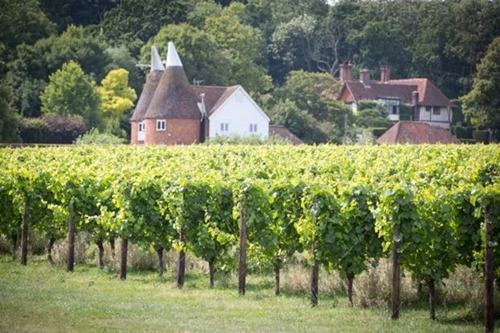
Hush Heath vineyard in Kent.
In 2002, the British Broadcasting Corporation organized a
poll to find out who were considered the greatest British people who ever
lived. You can probably guess a few of them yourself. It turned out that
William Blake, the slightly eccentric English poet and painter was placed at
Number 38. If these things interest you, I shall leave you to find out who
the others were but sadly, I am not among them.
William Blake was unrecognized during
his lifetime but he’s now considered a key figure in Romantic art and
poetry. It is he who gave us the expression “England’s green and pleasant
land” which first appeared in the rather surreal and supposedly prophetic
poem of 1804 entitled Jerusalem. It was written when Blake was living
in his cottage in Felpham, a small village near the Sussex town of Bognor
Regis. The village lies in the heart of England’s wine country.
Wine making was introduced to Britain
by the Romans, who occupied the country for well over three hundred years.
The Domesday Book of 1085 lists over 40 vineyards in England and by
the time Henry VIII was crowned at the turn of the 16th century
there were 139 vineyards in the country. Today there are more than 500 in
England and also a couple of dozen in Wales.
For a variety of economic and political
reasons, English wine had entered a dark age during the 19th century
and by the First World War, wine production had ceased completely. Although
attempts were made to kick-start the wine industry in the 1930s, it wasn’t
until the 1960s that it started to get back on its feet.
In subsequent years things improved,
largely due to increased expertise, climate change and market demands.
Today, many parts of southern Britain are dry and warm enough to grow high
quality grapes and the soil seems to suit them too. It’s in the interest of
farmers as well, because grapes produce far more income per acre than
traditional English crops such as wheat.
Generally, cool-climate grapes are best
suited to England, including Seyval Blanc, Reichensteiner and the
cross-breed variety Müller-Thurgau. Bacchus is a German hybrid white grape
created in the 1930s and it’s the grape of choice for many English
wine-makers.
Initially, only white grapes could be
grown there, but the warmer climate is allowing the production of red wines
too. The red grapes Pinot Noir, Gamay and Dornfelder are now appearing in
English vineyards.
The counties along the southern coast -
Kent, Sussex and Hampshire - are the home of some of England’s best-known
vineyards. Kent currently has the largest area under vine, its largest
producers being Gusbourne Estate and Chapel Down.
England is also producing world-class
sparkling wines from traditional Champagne grapes such as Chardonnay, Pinot
Noir and Pinot Meunier.
Award-winning sommelier Marc Almert
writes, “British sparkling wines are currently on everyone’s lips in the
international wine world. On average, the climate in southern England today
is like that of Champagne twenty years ago. The soils of the vineyards
around Sussex and Kent also have high lime content, similar to that in
Champagne. No wonder that England is currently one of the most dynamic
sparkling wine regions in the world.”
The French Champagne companies must
have been eyeing this English success with interest, to say the least. Three
years ago, the distinguished French Champagne house Taittinger planted its
first vines in 170 acres of farmland near Selling Court Farm in Kent. Some
of the locals may have wondered whether this was a portent of a second
Norman invasion.
Many English wine companies have been
tremendously successful. One of them is Nyetimber Wines. Thirty years ago,
Stuart and Sandy Moss planted a vineyard in the district of Nyetimber in
West Sussex, not far from where William Blake wrote his famous poem. Their
first wines were released in 1997 and promptly won a Gold Medal at the
International Wine and Spirit Competition. The company has gone from
strength to strength and a few weeks ago announced a major planting of over
100 acres near the village of Thurnham in Kent. Two hundred thousand Pinot
Noir and Chardonnay vines have already been planted.
So which are the best English wines to
look out for? Well, I am afraid the bad news is that you’ll probably have to
go there to buy them. As far as I am aware, there are no UK wines yet
available in Thailand. If however, you can persuade someone to bring you a
sample when all the current problems subside, there are several excellent
outlets in the UK all of which offer online service.
Majestic Wine is a well-established
company that offers an excellent selection of English wine. Other important
outlets are Grape Britannia, Elizabeth Rose English Wines, Hawkins Brothers,
The British Wine Cellar, The English Wine Collection and Hennings Wine.
These companies together offer an incredible selection of fine wine. If you
are planning a future trip there, be sure to seek out some of the superb
wines that the UK has to offer.
|

|
North of the Border
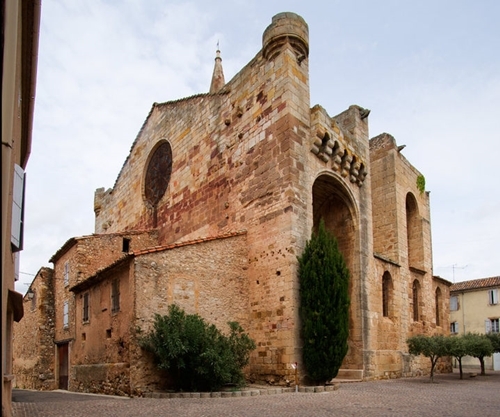
Sainte-Eulalie de Cruzy. (Photo: Francois Werth)
Next time you visit Toulouse to see how they’re getting along with your
custom-built Airbus, you can pass the time by renting a car for the day. If
you were to drive down the A61 or the A64 for a few miles, you would soon
find yourself in the Comté Tolosan.
This is a massive wine-growing region that covers the
whole of South-Western France and reaches down to the Spanish border. They
produce more than five million gallons of wine every year there using the
usual well-known grape varieties but also many local varieties.
You might never have heard of Gros Manseng, Loin de
l’Oeil, Duras, Fer Servadou or Négrette but they all hang out in Comté
Tolosan and almost nowhere else in the world. The region is a part of the
so-called Aquitaine Basin, which includes the plains that fall between the
Pyrenees, the Massif Central to the East and the Atlantic Ocean to the west.
I don’t want to bore you comatose with technical stuff,
but there’s something you need to know. Between 2006 and 2012 the French
revised their traditional system of wine classification. If this is news to
you, please sit up and listen carefully because I am not going to bother
explaining it all again. In a nutshell, the result was that wines previously
classed simply as Vin de Pays (“country wines”) had to show the
rather more prosaic classification of Indication Géographique Protégée
(IGP) on their labels. The rock-bottom category of Vin de Table
(which hardly needs translation) was changed to Vin de France. The
top designation, which used to be Appellation d'Origine Contrôlée (AOC)
was replaced with Appellation d'Origine Protégée (AOP). In 2011, the
rather useful classification of Vin Délimité de Qualité Supérieure (VDQS)
which had been introduced in 1949 was given the old heave-ho and
unceremoniously chucked out altogether.
Cuvée Montplo,
Comté Tolosan IGP (white), France
Both today’s wines hail from the strangely-named
Domaine Montplo which lies to the east of Comté Tolosan in the region known
as l’Hérault (lair-OH). It stretches from the shores of the
Mediterranean to the Cévennes Mountains in the north. At its centre lies the
ancient town of Béziers, known among other things for the local obsession
with bullfighting. Domaine Montplo is tucked away in Cruzy, a small wine
village about thirty minutes’ drive north of Narbonne.
At first sniff, the wine smells a vaguely like a
Chardonnay but it’s actually a blend of Colombard and Ugni Blanc. You may be
unfamiliar with Ugni Blanc, but it hails from Italy, where it’s known by the
more familiar name of Trebbiano. This wine is pale yellow with hints of
green and it has a lovely floral aroma of pineapple, melon, citrus fruits
and honey.
When the air gets to the wine, you’ll find that both
the aroma and taste open up beautifully. Comté Tolosan white wines are known
for their aromatic qualities and this one is no exception. It has a soft,
seductive and almost creamy mouth-feel, plenty of tropical fruit up-front
and hardly any acidity. It’s not quite as dry as the proverbial bone, but
it’s dry nonetheless and there’s a touch of pleasing acidity on the long
finish.
It would work well with seafood but would be perfect
with a simple salad. This is a really lovely wine and at only 11.5% alcohol
content, I’d be quite happy to drink it on its own all evening. In fact, I
think I will.
Domaine de Montplo, Pays d’Hérault IGP (red), France
The vineyards of Domaine de Montplo lie to the west of
Béziers, on stony, clay-based soil. They are planted on hillsides at 200
metres altitude and benefit from proximity to the rocky scrubland and its
wild herb aromas. Mind you, the aroma of this
attractive, dark red wine is a bit shy at first. But if you’d been stuck in
a bottle for two years, hauled from France to Thailand then dumped in a
storeroom for a couple of weeks, you’d probably feel a bit withdrawn too.
Eventually, when the wine has had some air contact, you’ll pick up fruity
aromas of blackberry, plum, blackcurrant and raspberry. It’s worth waiting
for.
The wine has a beautifully
soft texture with loads of fruit on the palate. It’s balanced, well-rounded
and perfectly dry with a foundation of supple tannins. There’s a very
satisfying long, dry finish with just enough tannin to remind you that this
is a real French wine, not a Californian crowd-pleaser.
It’s made from two local
grape varieties, Carignan and Grenache, the second of which also happens to
be one of the most widely planted red grapes in the world. At just 12%
alcohol content it would make an excellent partner for light meals,
especially with cheese.
By the way, both these wines
come with a very welcome screw cap (or “Stelvin closure”, if you want to
impress your friends). I’ve grappled with so many corks in my time that a
screw cap comes as a great relief. Yes, I know it lacks a certain mystique
and romance, but there again, so does an Airbus.
The wines described in this column
are generally available in Thailand, either from local outlets or from
online wine suppliers.
PHOTO:
|

|
Rose-Tinted Spectacles
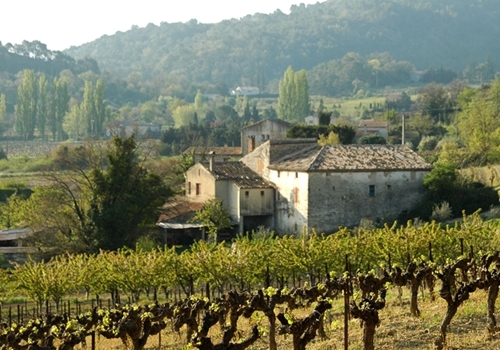
Provence: home of fine rosé.
It’s a curious expression when you come to think about it,
yet I suppose most English speakers know what it means. I think I was
wearing them when I first visited Thailand over thirty years ago. Everything
seemed so fresh, new and inviting; everyone warm and friendly and I became
enchanted by the country. I don’t think I even noticed the dirt and piles of
rubbish in the grubby sois of Bangkok. But why the colour “rose” I wonder?
In 2015, psychology researchers Andrew
Elliot and Markus Maier wrote, “Given the prevalence of color, one would
expect color psychology to be a well-developed area. Surprisingly, little
theoretical or empirical work has been conducted to date on color’s
influence on psychological functioning, and the work that has been done has
been driven mostly by practical concerns, not scientific rigour.”
Even so, in popular imagination colours
often tend to be associated with human feelings or emotion. Past
experiences, cultural influences, personal taste, and other factors probably
influence how individuals respond to particular colours. In many cultures,
rose-pink is often considered a peaceful colour associated with love,
kindness, and femininity. Remember the old wives’ adage about “blue for a
boy and pink for a girl”? It seems that colour associations are reinforced
from an early age.
So what about pink wine? It’s usually
described as rosé, a French word meaning much the same thing. If you
are of a certain age you may recall Mateus Rosé, a brand created in
1945 and designed for mass market appeal. It’s sweet and slightly fizzy and
still going strong in its distinctive flask-shaped bottle. Rosé wine has
come a long way from being the simple glugger of the 1970s, when Hugh
Johnson wrote, “Buy the cheapest rosé you can find, for there is not much to
choose between them.” Today of course, that is no longer true. Rosé has
achieved popularity largely because it has become so much more interesting.
It is no longer chic to be sniffy about rosé. In France, more than one in
five bottles of wine sold is rosé where it has become a popular light drink
or apéritif.
Anyway, let’s get to business. By
definition, rosé is a type of wine that incorporates some of the colour from
the skins of red grapes. Almost any variety of red grapes can be used to
make it, though Shiraz and Grenache are popular among winemakers. Rosé is
aromatic, light and fragrant (or should be) with reminders of fresh cut
flowers and ripe red fruits like strawberry and cherry. Sometimes there are
tantalizing hints of delicate floral aromas, oranges, grapefruit or lychee.
Rosé works well with most foods and for something to accompany a light snack
it’s perfect, especially when served ice-cold. European rosé tends to be
dry especially the dry-as-a-bone rosé from the South of France. If you
prefer dry wine, stay with European rosé because many New World examples are
usually on the sweet side. Many companies also make sparkling rosé.
You might be surprised to know that
both red and white grapes produce clear, colourless juice when pressed. The
colour comes almost entirely from the grape skins. There are several ways to
make rosé but the most common is known as maceration (or soaking),
which involves leaving the skins to soak in the newly-crushed grape juice
for a limited amount of time. It can be anywhere between six to forty-eight
hours, depending on the style of wine needed. And incidentally, rosé is
rarely a simple pink. The colour can range from a pale “onion-skin” orange
to a vivid near-purple, depending on the grape used and the length of the
maceration.
You may be wondering where you can buy
rosé in this neck of the woods. Rosé should always be consumed when it’s
young and fresh, so it’s generally safer to buy it where you can be
reasonably sure of a rapid turnover. Wine Connection has several branches in
Pattaya and they have a few interesting rosé wines on offer including a
couple of typical dry ones from the South of France. The online wine company
Wine-Now.Asia appears to have a splendid selection of rosés from all over
the world. There are many interesting examples under Bt 750 including the
excellent Paul Jaboulet Parallèle 45 Rosé. If you’re prepared to fork
out up to Bt 900 there some even more tempting offers from this company.
You might be surprised to know that
rosé is also made in Thailand. One of the entry-level examples is Monsoon
Valley Rosé which comes from Siam Winery. A bit further up-market is the
excellent PB Valley Khao Yai Reserve Rosé which is a lovely dusky
pink with tantalizing hints of orange. One of the most fascinating Thai
rosés I have come across is the award-winning GranMonte Sukana Syrah Rosé,
made from 100% Syrah grapes grown in Central Thailand. It’s a lively and
refreshing wine with delightful fruity aromas and available online via the
GranMonte website at about Bt 940. This is one of the best examples of a
quality Thai rosé that you are likely to encounter. But don’t forget, always
serve rosé really cold.
|

|
Clochemerle Country
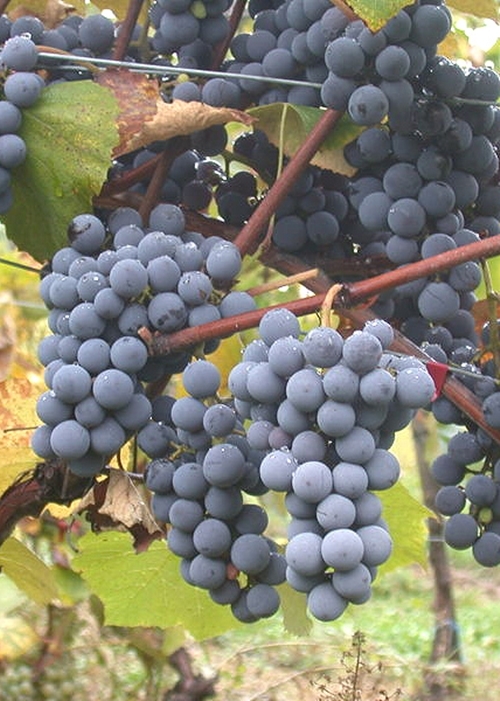
Gamay grapes on the vine.
If you’re over a certain age, you may recall the French
satirical novel Clochemerle. It was written by Gabriel Chevallier and
first published in 1934 though the English translation didn’t appear until
some years later. The book is set in a fictional Beaujolais hamlet of the
same name and the story revolves around the local squabbles surrounding the
installation of a public urinal. In 1972, BBC television produced a popular
series based on the novel, much of it filmed on location in France. The
British viewers must have thought they were being given a glimpse of The
Real Beaujolais but the location sequences were actually filmed in the
village of Colombier-le-Vieux over ninety miles to the south in the Ardèche
region.
The area known as Beaujolais (boh-zjuh-LAY)
lies south of Burgundy and extends about thirty-five miles from the rolling
hills south of Mâcon to the flatter lands north of Lyon. The region was
first cultivated by the Romans, who sensibly planted vines along their
trading route up the Saône River valley to provide sustenance for travelers.
Unlike the red wines of Burgundy which rely totally on the Pinot Noir grape,
Beaujolais is made solely from Gamay, a purple thin-skinned grape which is
low in tannins. Almost all the wines made there are red, full of fruit, easy
to drink and food-friendly.
Beaujolais Nouveau
is wine which has been fermented for just a few days and released on the
third Thursday every November. Technically it’s known as a vin de primeur
and it has become famous for the races by distributors to get the first
bottles to different consumers around the world. Contrary to popular belief,
it’s not a modern fad because the origins of Beaujolais Nouveau date back to
the 19th century
when the young became all the rage in Paris. These sprightly wines are meant
to be enjoyed as young as possible, when they’re at their freshest and
fruitiest.
In his splendid book Adventures on
the Wine Route, Kermit Lynch writes, “What a concept, downing a newborn
wine that has barely left the grape, a wine that retains the cornucopian
spirit of the harvest past.” But Beaujolais has changed, much to the chagrin
of the Old Guard. Fifty years ago it was simpler stuff, sometimes a bit
rough at the edges and rarely exceeded 10-11% alcohol content. Today it is
more likely to be 12.5% and crafted for more sophisticated customers who
demand fuller flavour, smoothness of texture and – let’s face it - a bit of
class.
The quality levels of Beaujolais are
easy to understand because there are only three. The lowest is labeled
simply Beaujolais and it’s a basic blend using cheap grapes from
anywhere in the region. A wine labelled Beaujolais Villages is at the
middle level and covers blends from any of thirty-nine small villages in the
northern part of the region. Wines from these villages are considered
superior to ordinary Beaujolais in that they have more complex aromas and a
more satisfying concentration of flavours.
The top-level wines are known as Cru
Beaujolais and come from just ten villages in the foothills of the
Beaujolais Mountains. The hilly terrain, granite base and sandy clay soil
provide an ideal environment for Gamay to express itself to perfection. The
name of the individual village usually dominates the label and sometimes the
name Beaujolais is omitted altogether. These are the most interesting
Beaujolais wines you can buy because each village produces wine with its own
special characteristics. In Thailand you might – if you’re lucky – come
across Brouilly, Chénas, Fleurie, Morgon and Moulin-à-Vent. These are
longer-lasting wines and unlike ordinary Beaujolais, they can keep for
several years.
I once found some half-bottles of quite
old Moulin-à-Vent in an old and dusty wine shop in South London. They were
well over ten years old but still youthful by Moulin standards – some of
which can age for decades. The wine was superb: rich dark fruit, earthy
woodland aromas and a stunning velvety texture. The next morning I drove
back the shop and bought the few bottles that they had left.
You’re unlikely to come across such
treasures in these parts but if you buy Beaujolais, look out for the
respected names of Bouchard, Drouhin, Duboeuf and Jadot. If you’ve not yet
had to opportunity to taste Beaujolais, you might be wondering what it
tastes like. Well, Beaujolais is made to be enjoyed young, when it’s full of
youthful exuberance. Part from the distinguished Cru Beaujolais, most
of the wines are typically youthful, light-bodied and with fresh acidity.
Beaujolais tends to have soft, jammy aromas of red fruits such as
strawberry, raspberry or redcurrants and the better quality ones come with
forest aromas which might even remind you of Pinot Noir. They usually have a
gentle mouth-feel and light tannins. These charming wines make a lovely
accompaniment for summer or al fresco meals. Ordinary Beaujolais goes
perfectly with light meals, omelets, vegetarian dishes and salads and even
with light chicken dishes. But do as the French do, and always drink it
slightly chilled. Of course in that part of France, it’s the daily swig for
in those rustic regions they consume little else.
|

|
Air Power
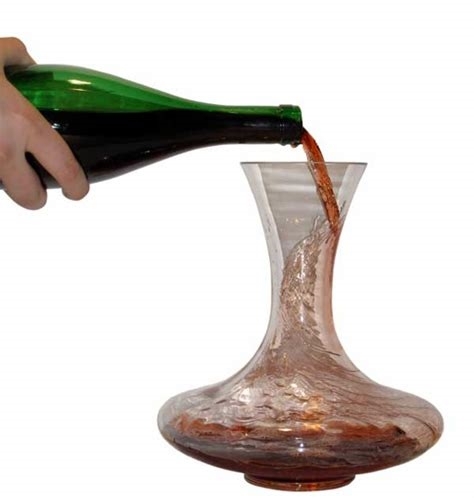
Decanting wine.
One of the most heated arguments among wine
enthusiasts is not really about wine at all. It’s about whether you should
pour it directly from the bottle into the glass, or whether you should first
pour it into a decanter. Red wines that have been in the bottle for several
years sometimes develop sediment. White wines rarely do, though tartrate
crystals are sometimes found in older whites. There’s nothing wrong with
sediment, it’s just the dead yeast cells and other tiny insoluble fragments
that settle to the bottom of any wine container. However, it looks a bit
unsightly and few people like to encounter black grit at the bottom of their
glass. Decanting is the process of separating the wine from the sediment.
But more of that in a moment.
Aeration is a simple
process which enables the oxygen in the air to react with the wine and
enhance the flavors and aromas. Some people (and many waiters) seem to
believe that having opened the bottle, it should then be left to stand for a
couple of minutes “to breathe”. This is nonsense, and I shall tell you why.
When the bottle is standing on the table, only the wine in the narrow neck
of the bottle is exposed to the air. This tiny surface area is far too small
to make any significant difference. It’s better to simply pour the wine into
the glasses and let it rest for a few minutes.
If you are at home
rather than in a restaurant, you can aerate the wine by tipping the whole
lot into a wine jug or decanter. But if you drink only a couple of glasses
at a time rather than an entire bottle, consider buying a device called an
aerator. There are two main types and both are inexpensive. One type is held
above the glass while you pour the wine through it, but the process can be
messy especially if your eyesight is not so good. It’s probably safer is to
use the other type of aerator that fits into neck of the bottle and also
acts as a stopper.
Aeration is something
of a battle-ground among some wine experts. Professor Emile Peynaud, the
distinguished French enologist believes that any oxygen damages wine
and you should always pour wine straight out of the bottle into the glass. I
have to say that few other experts would agree with him. I usually taste the
wine first before I decide whether to aerate it. Nine times out of ten, I
prefer aeration unless of course it’s sparkling wine which is never
decanted nor aerated. If you use boxed wine, a decanter is pretty well
essential. It doesn’t need to be an expensive one either. I use plain,
simple glass decanters, made by Ocean and available at any decent kitchen
shop for well under 100 baht each. They come in a variety of sizes. If you
are sharing a bottle with two other people, you can pour the entire contents
into three 25cl decanters. This ensures that everyone receives their fair
share and avoids unseemly fist-fights later.
You don’t need to pour
cheap wines gingerly as though they’re liquid gold, once you’ve got the top
of the bottle over the decanter, just let the wine slosh in, so that the
oxygen can really get to work. This is probably best done in the kitchen
rather than at the table, in case you make a complete hash of it. And here
you may detect the voice of experience.
Nearly all the world’s
wine is made for early consumption and not intended for ageing, so sediment
is unlikely in any wine you pick up at the supermarket. Unless you drink
vintage port or old and expensive wines from Bordeaux, Burgundy or Italy
you’ll probably never need to bother decanting. There’s no mystique in
decanting, but it does require a little practice. If your wine has been
stored horizontally (which it should have been) place the bottle upright at
least a day before opening. This ensures that any sediment settles at the
bottom. When you’re ready, gently remove the cork, grasping the bottle as
steadily as possible. Then hold it over the neck of the decanter (the
bottle, not the cork). Pour in the contents gently and steadily until the
bottle is almost horizontal. As soon as you see sediment approaching the
neck of the bottle, stop. It’s easier if there’s a bright light behind the
bottle. Traditionally, a candle was used (no doubt with many cases of burnt
fingers) but a small LCD torch is even better.
I suppose in the end,
while decanting is a necessary chore for many older red wines, aeration is
partly a matter of personal taste. If you prefer your wine tasting tight and
firm, pour it straight from the bottle, but if you want it to open up a bit
pour it first into a decanter or wine jug. You may want to use a decanter
when the wine bottle has an especially ugly or cheap-looking label, or you
may want to conceal the fact that you are dishing up cheap plonk. Far be it
from me encourage dishonesty, but an elegant decanter will help to preserve
your guilty secret.
|

|
Pizza Wine
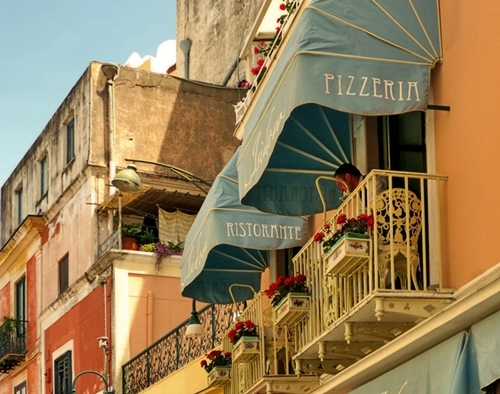
Pizzeria in Capri (Photo: Elijah Lovkoff).
The entrepreneur, restaurateur and author Peter Boizot once
wrote, “After one of his rapturously received performances at the
Metropolitan Opera in New York, the great tenor Enrico Caruso was asked for
his secret. How did he control such power and passion and project such lush
sweeps of melody? Looking his questioner straight in the eye, Caruso replied
È la pizza, la pizza, caro mio. (“It’s the pizza, the pizza, my
dear.”) Caruso was paying unusual tribute to a great national dish of his
own country which was not particularly well-known outside Italy at that time
– except, as it happened in New York itself, where Italian immigrants had
introduced the tradition of the pizza.”
Many years ago in London, I used to
visit some of the original Pizza Express restaurants which were
founded by Peter Boizot in 1965. One of them was a stone’s throw from the
British Museum in a dark, narrow side street that probably hadn’t changed
very much since the time of Charles Dickens. On one occasion at the
restaurant, an earnest young Spanish waiter informed me that because there
were some slices of mushroom on my pizza, I should be drinking white wine
with it, not red. This of course was absolute and total nonsense and exuding
as much sweetness and charm that I could muster, I told him so.
Wine has always been the traditional
accompaniment to pizza. Indeed, in many European countries, wine has always
been a staple item at the dinner table partly because it was considerably
safer to drink than water. Pizza was sold in the taverns and on the streets
of Naples in the sixteenth century, though Peter Boizot hinted at its
Neolithic origins when he wrote, “in its simplest form, the pizza…could have
been invented by anyone who had learned the secret of mixing flour with
water and heating it on a hot stone.”
Pizza has come a long way since then
but it remains a simple dish, though it can have countless variations and
fascinating flavours. It’s relatively easy to make too. I’ve been making my
own for years, though the dough-kneading process can be a bit of a bore. To
my mind, simple food needs simple wine. And wine it must be, because pizza
cries out for wine. It’s unlikely that people in sixteenth century Naples
spent much time discussing the most appropriate wines. They’d simply drink
whatever happened to be available locally. And there would have been plenty
of choice, because Naples lies in Italy’s Campania region where wine has
been produced since the 12th century
BC. It’s one of Italy’s most ancient wine regions with a vast number of
grape varieties, some of which are found almost nowhere else on earth.
Today’s wines from the Campania region tend to be fruit-forward and youthful
and many of them would make perfect matches for pizza. However, you’ll
probably be hard-pressed to find Campania wine in these parts.
The ideal pizza wine is what the
Italians call vino da pasta, which is any inexpensive light table
wine knocked back with almost every meal and usually served on the cool
side. Yes, I know that some people prefer to drink beer with pizza, but if
you must, try to find a strong Italian beer like Nastro Azzuro.
With simple food like pizza, almost any
crisp, dry, wine will do. It can be red or white but if it also happens to
be Italian, so much the better. Italian wine is made for food. Although some
people like hearty wines with pizza, I prefer to drink light-bodied wines
regardless of the toppings. My preference would be a Valpolicella or a
Bardolino (red) or a crisp dry Frascati or Soave (white). I should stress
here that these are merely my wines of preference, not what I actually get
to drink. If you like something a little more assertive, basic Chianti
would work well with its savoury, herbal hints that come from the Sangiovese
grape. There’s no need to choose a white wine just because your pizza has a
few bits of chicken on the top. It’s the dominant flavours that count. But
if you are having a seafood or vegetarian pizza Sauvignon Blanc or a light,
dry rosé would be excellent choices.
The whole business of pairing pizza and
wine is pretty basic and boils down largely to whether you want the food and
wine to complement each other or whether like me, you prefer contrast. For
example, if you’re having a “heavy” pizza with lots of rich meat, you can
match like-with-like by selecting a full-bodied wine like a warm-climate
Cabernet Sauvignon or Shiraz. Alternatively, you can contrast your “heavy”
pizza with a light-bodied wine. It’s entirely up to you. Feel free to be
adventurous and try to experiment. Perhaps in these challenging times, you
might even finish up, as I so often do, with Mont Clair. But that’s better
than nothing, and with a bit of determination and will-power you can almost
convince yourself that it’s actually Valpolicella from sunny Italy.
|

|
Classic Reds
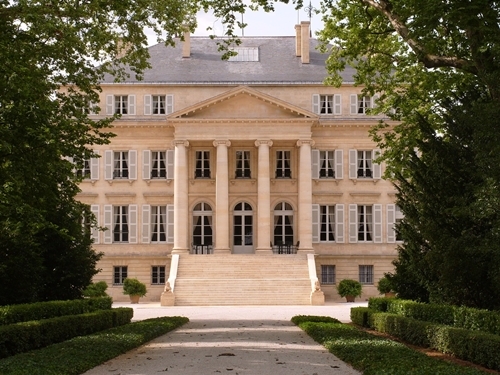
Château
Margaux (Photo: Colin Burbidge).
If you mention the name
“Bordeaux” to wine lovers, don’t be surprised if their eyes glaze over and
their salivary glands get to work like those of Pavlov’s slobbering dogs.
Because you see, for wine enthusiasts Bordeaux is rather special. Any red
wine from the Bordeaux region used to be called “claret” in Britain,
regardless of its origin or pedigree. The British have used this word for
the last three hundred years yet today it’s unknown in France. It’s always
pronounced “cla-rett” and never, as some nitwit once told me, “cla-ray”.
I suppose the word will eventually join the mausoleum of other defunct but
delightful English words along with hobgoblin, postilion, whirligig and
quagswagging, which in case you’re wondering, means shaking something to and
fro. My parents always used to speak of “listening to the wireless” and
avoided the word “radio” as though it was slightly vulgar. Future
generations will probably regard anyone who talks about “the wireless” as
faintly dotty if not actually barking mad.
So what can I tell you about Bordeaux
that you don’t already know? Well, Bordeaux is in France. Of course, you
knew that. Even my dogs know that. I suppose Pavlov’s dogs knew that too.
Furthermore, Bordeaux is almost half way between the North Pole and the
Equator. To be more precise, it’s two-thirds of the way down France’s
Atlantic coast and the city of Bordeaux lies on the 44th parallel
along with Minneapolis and Montreal.
The Atlantic Ocean and the rivers
Gironde and Dordogne, together with the warming effect of the Gulf Stream
have a significant impact the climate of Bordeaux. The name itself is a
contraction of the French expression au bord de l’eau which
translates roughly as “next to the waters”. They’ve been making wine there
since the 8th century
and today this region of 400 square miles is home to ten thousand wine
producers. Bordeaux wine is available at all levels of quality and price.
The prices of top quality Bordeaux wine vary from year to year depending on
the weather and therefore the quality of the vintage. For example, the years
1961, 1982, 1990, 2000 and 2009 produced superb wine while the 1991 and 1992
vintages were a complete washout.
We can’t talk about Bordeaux wine
without mentioning the so-called 1855 Classification. It was created at the
request of Napoleon III (the eponymous nephew of the famous one) who wanted
to showcase Bordeaux wine at the 1855 Paris World Exhibition. Local experts
ranked what they considered the Top Sixty reds of the Gironde region of
Bordeaux in order of importance from first growths (or cru) to fifth
growths. Surprisingly, the classification still holds today with only a few
minor changes. Every wine professional knows this list of Grands Crus
by heart. The five chateau named among the First Growths (Premiers Crus)
include such illustrious names as Château Lafite Rothschild, Château Latour
and Château Margaux which together produce some of the finest red wines in
the world. When aged, they develop into sensational wines, each with its
unique character.
They don’t come cheap. For example, the
UK price of a bottle of the year 2000 Ch. Latour is the equivalent of 39,000
baht and a bottle of Ch. Mouton Rothschild of the same year will set you
back 88,000 baht. You can double these prices for Thailand. But because of
the enormous world-wide demand, you would be hard-pressed to find any
grand cru wines in this country except at the most exclusive places.
However, you don’t need to sell the
family car (or the family) to buy a bottle of Bordeaux. The annual output
is about 900 million bottles and apart from that tiny minority of grand
cru wines, many of them are entry-level wines intended for everyday
drinking and labeled either Bordeaux AOC (Appellation d’origine contrôlée)
or Bordeaux Supérieur. The Bordeaux locals drink little else. You can easily
find this style of wine in Thailand and the online companies Wine-Now.Asia
and Wine Connection stock a decent selection of everyday Bordeaux
starting at under Bt 1,000.
If you’ve never tasted Bordeaux, you
might be wondering what to expect. Well, the signature grapes of Bordeaux
are always Cabernet Sauvignon or Merlot. Many winemakers use a blend of
these two grapes and nothing else. Sometimes other grapes are added to
improve the blend, notably Cabernet Franc, Petit Verdot and Malbec. Good
ordinary Bordeaux tends to be dry and firm-bodied with aromas of plum and
blackcurrant. It’s restrained in style and is usually high in tannins giving
it a firm structure. Sometimes there are touches of spice and hints of soft
fruit but these are always subtle and the polar opposite to some of the
Cabernet Sauvignon fruit bombs from Australia.
Many entry-level Bordeaux wines are
labeled Château something-or-other giving the impression of a stately
home surrounded by immaculate gardens and vineyards. This is merely a
marketing ploy. A wine company can legally sell identical wines under
different and totally fictitious châteaux names. It’s estimated that there
are ten thousand château names in use today. The wine in a bottle of cheap
Bordeaux may be perfectly good, but the picturesque château shown on the
label probably doesn’t exist.
|

|
Changing Latitudes
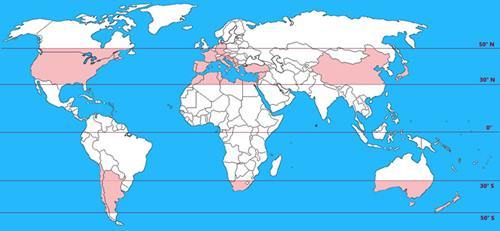
Map showing 30°-50° latitudes.
If you wander through the wine section
of a typical supermarket you might get the impression that wine comes from
all over the world. But you’d be wrong. The bulk of the world’s wine
originates from grapes grown between 30 and 50 degrees of latitude in both
the Northern and Southern hemispheres. The Northern Hemisphere is by far the
larger wine producer because this band covers much more land, whereas the
Southern 30-50 degree band is mostly over oceans.
But perhaps you have forgotten what
“latitude” means, especially if your geography is a bit hazy. So let me
explain. On a map or globe of the Earth, latitude is shown by imaginary
horizontal lines like hula hoops around the surface from the equator to the
two poles. On a map, like the one shown here, they appear as straight lines.
They’re sometimes called “parallels” because they run parallel to the
equator which is the starting point for measuring latitude so it’s
considered as zero degrees. Thailand is comparatively near the equator and
Pattaya lies 12° North. One degree of latitude is around 69 miles (or 110
kms) so Chiang Mai is almost 19° N. London is about 51.5° N whereas on the
opposite side of the world, Sydney is about 35° South (usually shown as
-35°). This of course is within the southern grape-growing comfort zone.
The vertical lines on a map or globe
indicate longitude and knowing both these values you can pin-point anywhere
on the globe. This is partly how your GPS device works. Surprisingly
perhaps, the concepts of latitude and longitude have been known since
ancient times. Mariners of old could determine their latitude from the
position of the sun, or at night from the positions of the stars. Finding
longitude however, proved a spectacularly difficult problem. In 1707 the
British Government offered a reward of twenty thousand pounds (equivalent to
four million dollars in 2020) to anyone who could devise an accurate way of
accurately determining longitude. But that’s another story. And a good one,
too.
But back to wine. Fifty years ago, it
was assumed that wine grapes would grow only between 30 and 50
degrees and nowhere else. We know now that grapes can grow far beyond this
range in places like India, Vietnam, Indonesia and Namibia. In the 1980s
Thailand pioneered wine production in a narrow band between 14-18°N. Today
several Thai wineries are producing award-winning wines from grapes grown at
these latitudes.
Latitude is only part of a complex
equation. The wine in your glass is the result of several other factors such
as climate, weather, soil, terrain and wine-making techniques. These are
often described as terroir (tair-WAH) a convenient French word
for which there is no exact English equivalent. Merlot grown in Bordeaux
doesn’t taste the same as Merlot grown in the Napa Valley because the
terroir is different. Climate is critical too and you’ll hear
expressions like “cool” and “hot” climate wines. Generally speaking, cool
climate wines tend to be light bodied with low alcohol, crisp acidity and
bright fruit flavors. Hot climate wines are usually fuller bodied with
higher alcohol, softer acidity and more lush fruit flavours. So you see,
your personal choice of wine might depend largely on climate.
Confused about climate and weather? The
American writer Robert A. Heinlein has the answer: “Climate is what you
expect, weather is what you get.” Few would disagree that our climate is
changing and this has an impact on viticulture. Eric Asimov is the wine
columnist for the New York Times. Last year he wrote, “Grape growers
especially have been noting profound changes in weather patterns since the
1990s. In the short term, some of these changes have actually benefited
certain regions.” He is right. While some wine areas have recently
experienced drought, heat waves and unexpected hail, others have been more
fortunate. For example, top quality English sparkling wine was unheard of in
the 1980s but today’s warmer climate is allowing English wine-makers to
produce world-class sparklers using the méthode champenoise. Not
surprisingly, new vineyards are being planted with enthusiasm in England’s
southern counties.
Climate change is providing
opportunities for more northerly regions to develop a wine industry and
grapes are now being planted in Belgium, Denmark, Norway, Sweden and even
Finland. Thirty years ago, only a lunatic would have contemplated planting
grapes at 59° N.
Winemakers have another problem
relating to climate change. Higher temperatures cause grapes to ripen
earlier. The sugar in the grapes turns into alcohol too quickly before the
all-important phenols have had sufficient time to develop. These phenols
include several hundred chemical compounds that enhance the colour, taste
and mouth-feel. Wine-makers now have to decide whether to harvest grapes
early, producing wine with acceptable alcohol levels but with less interest
and complexity. The alternative is to leave the grapes on the vine and wait
for the development of the phenolic compounds, risking wine which is too
high in alcohol.
And in case you’re wondering, the wine
industry produces only about 0.1 percent of global carbon emissions. Now if
you ask me that’s welcome news. Perhaps we should open another bottle.
|

|
Stone cold
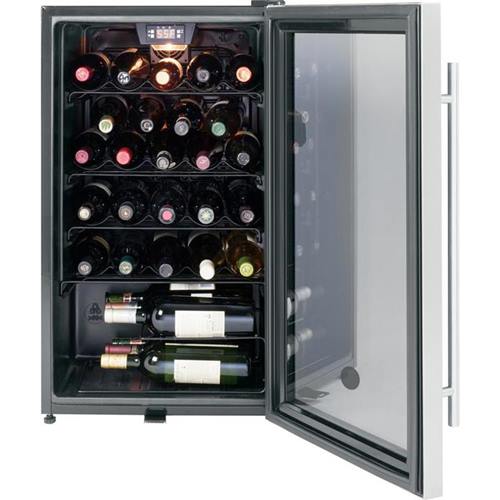
GE® Brand Wine Center.
Down at the watering
hole the other night, the subject of wine came up again. One of my
companions quoted that tired old cliché that he prefers “red wine at room
temperature”. I resisted the temptation to make an issue of it, but a
moment’s thought reveals that the statement is nonsense. For a start, it
implies that all red wine should be served at the same temperature which is
simply not true. More importantly the temperature of a room depends on many
variables, especially in this part of the world. As I am typing this, the
temperature in my study - with all the windows open is about 33°C (91° F).
Only a lunatic would drink wine as warm as that.
Wine temperature is critical. And
before you protest about this being a subjective matter, remember that we
are not talking about personal taste here, but how to taste the wine at
its best. Experts agree that every wine has its optimum serving
temperature. One of the biggest mistakes people make is drinking wine too
warm, or more usually in these parts, too cold. Even the cheapest plonk
taste better at the appropriate temperature.
Generally speaking, young or
light-bodied wines taste better at lower temperatures whereas full-bodied
wines are at their best several degrees higher. The “body” or “boldness” of
the wine is the result of several factors including grape variety, climate,
vintage, alcohol level and tannins. In case you’re wondering, tannins occur
naturally in vines and in oak barrels and have a distinctive taste that
makes your tongue feel dry. On the positive side, they add body and
character and they’re most noticeable in red wines.
Right then, let’s be a bit more
specific and start with some popular reds. If a full-bodied red is served
too cold the tannins taste rough and unpleasant, the aromas lie hidden and
the flavour feels unyielding. On the other hand, nothing ruins a red wine
more quickly than serving it too warm. Full-bodied reds such as Cabernet
Sauvignon, Syrah and Malbec are best at 16-17°C (61-63°F). You can include
virtually all Bordeaux, Burgundy or Rhône in this category. In cold-climate
areas such as Northern Europe, reds of this type are normally served at the
prevailing ambient temperature. Medium-bodied reds such as Chianti and
Valpolicella are best a little cooler at 13-15°C (55-59°F) and very light
reds such as Bardolino, Lambrusco or Beaujolais taste freshest when they’re
distinctly cool at 12°C (54°F). Rosé wines should always be well-chilled
around 8°C (46°F).
White wines also range from full-bodied
to light-bodied but unlike reds, they can also be sweet or dry. Whites
invariably taste better when they’re chilled because warm white wine always
feels flabby and dull. Full-bodied whites such hot-climate Chardonnay should
be slightly chilled at 9-10°C (48-50°F) and lighter whites such as Orvieto,
Pinot Grigio or Soave well-chilled at 8°C (47°F). Champagne and Prosecco
along with many sweet wines taste best when they are decidedly cold at about
7°C (45°F) which is pretty well straight out of the fridge. Sherry is
technically a white wine and it’s still a popular drink in the UK though
almost everyone makes the mistake of serving it too warm. In its home
country of Spain, it’s always well chilled to bring out the freshness. Don’t
worry about serving white wine too cold, because in our tropical climate
it’ll warm up all too quickly.
You’d be surprised at how rapidly this
occurs. As an experiment, I checked the temperature of a Chilean Chardonnay
straight out of the fridge. It was 3°C (37°F) and too cold for drinking.
Having sloshed the wine into a decanter to aerate it, I then poured a
sample. During this process, which took less than a couple of minutes the
wine’s temperature shot up to 10°C (50°F) which as luck would have it, is
just about right for Chilean Chardonnay. But then the glass of wine was left
unattended for five minutes during which time the temperature increased to
an amazing 15°C (59°F); far too warm to taste at its best. It was heating up
at one degree Celsius - or roughly two degrees Fahrenheit - every sixty
seconds. At a social occasion, the wine could be too warm before you
reach the end of the glass, especially there’s the usual chok dee
routine to endure before every swig. I should add that during my
not-too-scientific experiment in the kitchen, the air-conditioner was off,
because being half Scottish I tend to avoid reckless spending. In an
air-conditioned room of course, the rise in temperature would be a little
slower.
You can’t really check the temperature
by sticking your finger in the glass, though with practice you can become
quite proficient at estimating temperature. If you want to get it
consistently right, buy a wine or cooking thermometer. Lazada has a good
selection, including some cheap LCD bracelets that conveniently fit around
bottles.
Although different wines should be
served at different temperatures, all wines should be stored at
the same constant temperature which is about 13°C (55°F). Unless you can
afford an expensive wine storage cooler it’s probably unrealistic in this
country to store wine at home. The sensible solution is probably to buy wine
when you need it then stick it in the fridge before the bottle is opened.
Then let the bottle rest in an ice-bucket containing water (and some ice if
necessary) at roughly the right temperature. You can help white wine by
serving it in cold glasses, but not so cold that your guests drop them in
shock.
|

|
Glass Conscious
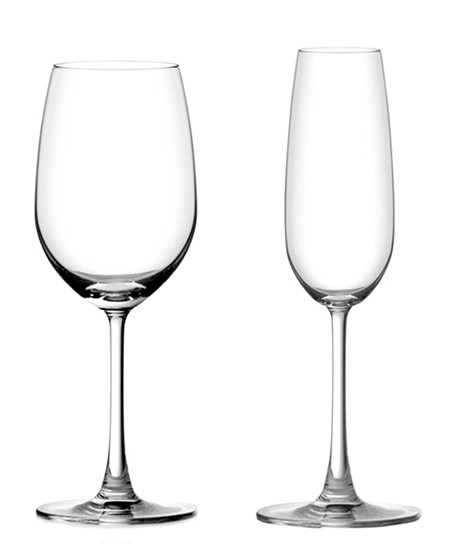
Madison red wine glass (L) and Champagne flute
from Ocean.
At a push, you could
probably drink wine out of a plastic mug, but you’d lose most of the aroma
and a good deal of the pleasure. Wine always tastes best out of a
well-designed glass but they come in a bewildering variety of shapes and
sizes. The distinguished Austrian firm of Riedel (REE-dull) was
established in the same year that Mozart was born and it has revolutionized
glassware by customizing the shape of wine glasses to a particular type of
wine. There’s a range of glasses for Cabernet Sauvignon, another type for
Shiraz, another for Riesling and so on. Wine expert Robert Parker considers
them the finest available. “The effect of these glasses on fine wine is
profound,” he writes, “I cannot emphasize enough what a difference they
make.” But quality doesn’t come cheap. Even one of Riedel’s cheapest glasses
can set you back 2,000 baht. And that’s just for one of them. Needless to
say, these are products for wine professionals and top-class restaurants.
Most of us usually have to settle for something a little more modest.
Even so, if you enjoy a variety of
different wines you really need three or four different types of glass: (1)
a medium-sized one for everyday plonk, (2) a larger one for quality wines,
and (3) a tall one for sparkling wines. You can safely forget about serving
white wine in a smaller glass, for a decently designed glass will do for
both red and white. If you drink Sherry a small copita is a useful
addition.
There are four main issues to consider:
shape, comfort, transparency and size. You may also be concerned about
price, so don’t buy glasses that you can’t afford to break. A tulip-shaped
glass is best, because it concentrates the aroma near the rim. The glass
should be well-balanced and not uncomfortably heavy, with a thin stem. The
rim should be wide enough to get your nose inside. A plain, transparent
glass is best because any form of colour or decoration is distracting. As to
size, it rather depends on the quality of the wine. Regardless of size, I’d
recommend the glasses produced by the Thai company Ocean Glass. It produces
an extensive range of wine glasses which are good value and widely
available.
For ordinary table wine the Ocean
Duchess range is fine. The 255ml (9oz) red wine glass is 19cm (7.50 in)
high and a pack of two is about 325 baht. If you crave something a bit more
classy and money is no object, you might be interested in Ocean’s superb
range of Lucaris crystal glasses, some of which are varietal
specific.
Quality wines require larger glasses
because you need to swirl the wine around to release the complex aroma. This
is why the glass shouldn’t be more than about a third full. The Ocean 425ml
(15oz) Madison red wine glass is a large elegant design standing at
22cm (8.6 in). I always use this for wine tasting and a pack of two costs
around 325 baht. If you prefer something a little cheaper and more compact,
Ocean’s Lexington range might meet your needs.
For sparkling wines you’ll need
something different. Forget those absurd saucers-on-sticks that were once
popular. They are useless for sparkling wine, or any wine for that matter.
Far better is the glass known as a Champagne flute. It’s an elongated
version of a standard glass and its extra height allows the bubbles to
develop so you can feel their tingle on your tongue. Ocean’s elegant
Madison Champagne flute is excellent. This 210ml (7.25oz) glass stands
at 23cm (9 in) and it’s beautifully tapered to show a sparkler at its best.
A pack of two is also about 325 baht.
But I must tell you that there’s one
thing that I find intensely irritating. Well, there are several things
actually, but the others can wait. It’s the sight of a person nonchalantly
holding a wine glass by the bowl, as though cradling a mug of hot cocoa. You
see, we should always hold our wine glass by the stem - ideally between the
thumb and first two fingers. That’s what the stem is for. It is most
definitely un-chic and socially taboo to grasp the glass by the bowl. Apart
from that, the physical appearance of the wine provides information but not
if your hand is covering the bowl and the glass is smeared with greasy
fingerprints. The serving temperature is usually critical and if you insist
on holding the bowl, the heat from your hand pushes up the wine’s
temperature. You’d be surprised how rapidly this occurs. Greasy fingerprints
also render the glasses more difficult to wash, and I speak from bitter
experience.
At wine tastings, you sometimes see
wine professionals holding the glass by the base, pinching it between the
thumb and forefinger. This looks slightly odd but it keeps the hand as far
as possible from the bowl. I sometimes find myself doing this but it’s
rather impractical, because you have to use your other hand to put the glass
down. Anyway, don’t let me catch you holding your glass by the bowl, or I
shall send the dogs around to sort you out. Just don’t say you haven’t been
warned.
|

|
Grape Expectations

Sketch of Dickens
in 1842.
On 7 February 1812, at
Mile End Terrace in Portsmouth, Charles John Huffam Dickens was born. He was
to become one of the world’s best-known English authors and regarded as the
greatest novelist of the Victorian era. He created some of the world’s
best-known fictional characters and during his lifetime, his novels enjoyed
unprecedented popularity. Even today, his books are still widely read.
Charles Dickens was not only a
novelist, newspaper editor and social critic; he was also a connoisseur of
fine wine. Ironically, although he wrote timeless classics such as Great
Expectations, Oliver Twist, A Christmas Carol, and A
Tale of Two Cities, his last piece of writing a few days before he died
in 1870 was a bit more mundane. It was a wine list. It took the form of a
single, rather untidy hand-written sheet summarizing all the drinks that he
had in the cellar at his splendid mansion called Gad’s Hill Place in Kent.
The quantity of beer, wine and spirits was enormous but included some of the
finest wines and liqueurs of the day. Recently this single piece of paper
was sold at Sotheby’s for over fourteen thousand dollars. You could buy a
lot of Mont Clair for that.
Among the drinks listed were a fifty
gallon cask of ale, an eighteen gallon cask of gin, a nine gallon cask of
brandy and a nine gallon cask of rum. The cellar also included dozens of
bottles of champagne and table wines. Dickens bought almost all of his wine
from the wine merchants Joseph Ellis & Son of Hill Street in Richmond,
originally founded in 1831. He must have been regarded as a good customer
because his wine list includes four dozen bottles of Champagne, five dozen
of Chablis, five dozen of Sauternes, six dozen of Claret and countless other
delights. But you get the idea. He wasn’t short of a bottle or two.
Interestingly, Dickens listed many of
wines by their place of origin such as “Volnay” or “Sauternes” rather than
by the name of their producer. This indicates that they were almost
certainly shipped to England in bulk and bottled by the wine merchant – a
common practice at the time. Dickens had good taste in Clarets – the generic
name still used in Britain for red wines from the Bordeaux region of France.
He had a few dozen bottles of top quality claret that even in those days
must have been expensive.
Yet, despite this wealth of booze in
the cellar, he was a moderate drinker for the time. One of my favourite
Dickens books is Pictures from Italy where the author took his family
for an extended stay in 1844. He had already achieved international fame as
a novelist, and his relentless energy drove him to explore many different
parts of Italy. It would have also presented him with the opportunity to try
to local vino. Wine is produced in every region of Italy, so Dickens
would have had plenty to choose from, though by modern standards, much of
the wine would have been fairly rustic. It would also have been cheap. In
his book The Wine Atlas of Italy, Burton Anderson explains that in
those days, a daily supply of village wine cost Italians less than their
daily supply of bread.
In Italy today, over eight hundred
different grape varieties are grown. If this strikes you as rather a lot,
it’s actually only the tip of the iceberg. It’s generally accepted that
there are about 24,000 different varieties of wine grape in the world. Many
of the less important varieties have remained in their places or origin and
never left. For example, the Ruzica Crvena, the Crljenak Kastelanski and the
Svrdlovina Crna have remained in Croatia, but perhaps this is because nobody
but the Croatians can pronounce the names.
On the other hand, some grapes have
boldly gone where no grapes have gone before. Take Chardonnay for example.
Its spiritual home is in Burgundy but it thrives almost anywhere wine is
produced and Bordeaux’s Cabernet Sauvignon shows up in nearly every major
wine-producing country in the world.
Only about 150 different grape
varieties are produced in commercial quantities and we can boil down this
number even further to the nine or ten so-called “classic” grapes, also
known as “international grapes”. These are the big names you should know.
Sometimes they’re made into ordinary wines, but in the right hands, the
right places and given the right time, they can produce some of the finest
wines in the world.
A few years ago, a survey was carried
out in the UK in which customers in wine shops were asked to name as many
grape varieties as they could. The amazing result revealed that few people
could name more than one or two grape varieties and some people couldn’t
think of any at all. And remember, these were not people picked off the
street - they were customers in wine shops. To my mind this level of
ignorance is staggering.
But I wonder how many of the “classic”
grape varieties you can bring to mind. Well, there’s Chardonnay and Cabernet
Sauvignon to give you a start. Can you name any of the others? I bet Charles
Dickens could.
|
|
 |
|
|
 |
|
 |

